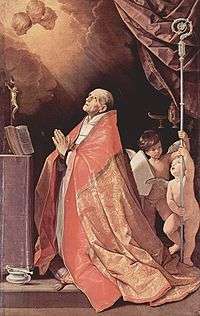Andrew Corsini
| St. Andrew Corsini, O.Carm. | |
|---|---|
|
St. Andrew Corsini in Prayer by Guido Reni (1630-1635) | |
| Religious and bishop | |
| Born |
November 30, 1302 Florence, Republic of Florence |
| Died |
January 6, 1374 (aged 71) Fiesole, Republic of Florence |
| Venerated in |
Roman Catholic Church (Carmelite Order and Archdiocese of Florence) |
| Beatified | 1440, Rome, Papal States, by Pope Eugene IV |
| Canonized | April 22, 1629, Rome, Papal States, by Pope Urban VIII |
| Major shrine | Church of Santa Maria del Carmine, Florence, Italy |
| Feast | February 4 |
| Attributes | holding a cross, with a wolf and lamb at his feet, and floating above a battlefield on a cloud or a white palfrey; a Carmelite friar wearing a mitre and cope |
| Patronage | Invoked against riots and civil disorder |
Andrew Corsini, O.Carm. (1302 – January 6, 1373), was an Italian Carmelite friar and bishop of Fiesole, who is honored as a saint within the Catholic Church.
Biography
Corsini was born in Florence on November 30, 1302, a member of the illustrious Corsini family. Wild and dissolute in youth, he became a Carmelite friar in his native city, began a life of great mortification. He studied at Paris and Avignon.[1]
On his return, Corsini became the "Apostle of Florence". He was regarded as a prophet and a wonderworker. In 1348 as the Black Plague was prevalent in area, he was appointed Provincial of Tuscany by the General Chapter meeting in Metz. The following year he was named Bishop of Fiesole. The inscription on his tomb says that "he was snatched from Carmel to the church and the miter of Fiesole". This likely gave rise to the story that he fled but was discovered by a child at the Charterhouse at Enna, and later accepted the nomination as bishop, as the result of a vision.[2]
Corsini redoubled his austerities as a bishop, was lavish in his care of the poor, and was sought for everywhere as a peacemaker, notably at Bologna, whither he was sent as papal legate to heal the breach between the nobility and the people.[1]
Reportedly, in 1373, while Corsini was celebrating the Midnight Mass of Christmas Eve, the Blessed Virgin appeared to him and told him he would leave this world on the feast of the Epiphany. It came to pass as the vision had told him, and he died on that day. After twelve years in the episcopacy, Corsini died in his native Florence on 6 January 1374,[2] at the age of 71.
Veneration
Miracles were so multiplied at his death that Pope Eugene IV permitted a public devotion to him immediately. It was only in 1629 that Pope Urban VIII formally confirmed this.[2] In 1675, after his canonization, the members of the Corsini family had the Corsini Chapel built in the Carmelite Church of Our Lady of Mount Carmel in Florence to provide his remains a more suitable resting place.
In the early 18th century, Pope Clement XII, born Lorenzo Corsini, erected in the Roman Basilica of St. John Lateran a magnificent chapel dedicated to his 14th-century kinsman.
His feast is kept on February 4 in the Carmelite Order and in the cities of Florence and Fiesole.
See also
References
- 1 2 Campbell, Thomas. "St. Andrew Corsini." The Catholic Encyclopedia Vol. 1. New York: Robert Appleton Company, 1907. 10 June 2016
- 1 2 3 "St. Andrew Corsini, Bishop", Order of Carmelites
- Attribution
![]() This article incorporates text from a publication now in the public domain: Campbell, Thomas Joseph (1913). "St. Andrew Corsini". In Herbermann, Charles. Catholic Encyclopedia. New York: Robert Appleton.
This article incorporates text from a publication now in the public domain: Campbell, Thomas Joseph (1913). "St. Andrew Corsini". In Herbermann, Charles. Catholic Encyclopedia. New York: Robert Appleton.
- Attwater, Donald and Catherine Rachel John. The Penguin Dictionary of Saints. 3rd edition. New York: Penguin Books, 1993. ISBN 0-14-051312-4.
- Lives of the Saints: Andrew Corsini (English)
- Catholic Forum: Andrew Corsini(English)
